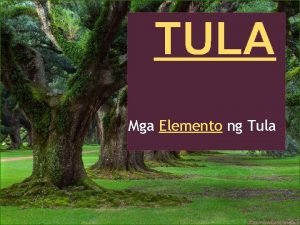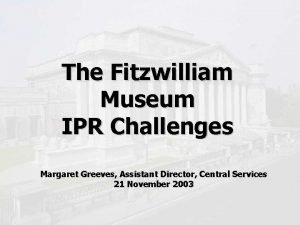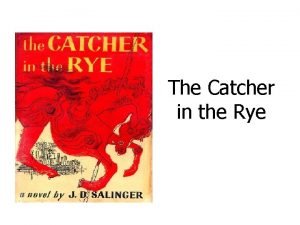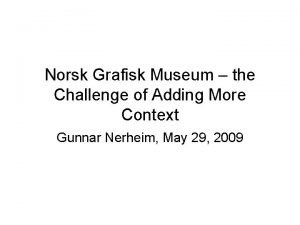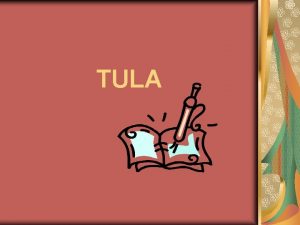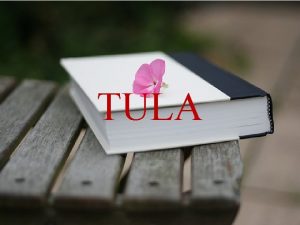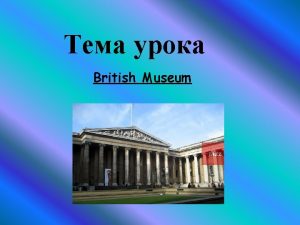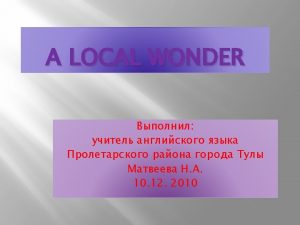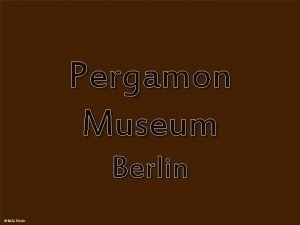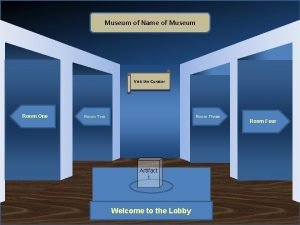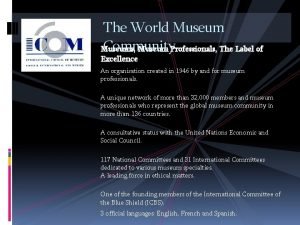Interactive Look A Museum Hour with Tula area

















- Slides: 17

Interactive Look «A Museum Hour with Tula area» Julia Andreevna Trofimova Form 10, School 14 Novougol’nyi Area, Donskoy, Tula Region Teacher: Lyudmila Vital’evna Los’kova

Click the Title and Learn Something New l a c i H r o t is s t h Sig Literature Mu sica l. T ula Welcome to Tula Region Spo rt Famous People s e R e n o Z t

Tula Region is part of the Central Federal District. It is situated in the central part of the East-European Plain. The region was formed on 26 September in 1937. Today, it is made up of 22 districts. It is bounded by Moscow, Ryazan, Lipetsk, Oryol, Kaluga Regions. Its main cities are Tula, Novomoskovsk, Donskoi, Uzlovaya, Yefremov, Yasnogorsk, Alexin and others. It has an area of 25 679 square kilometers. The population of Tula Region is more than 1, 553, 100 people (2009), most of those people live in towns and villages. Russians make up the majority of the population.

The Kulikovo Pole �It’s famous for the Kulikovo battle of 1380 which shaped the further destiny of the Russian state. �The battle became the beginning of the enfranchisement of the country from the Golden Horde yoke.

�It was built at the beginning of the sixteenth century. �It has been existed for almost five centuries. �It has nine towers. �It was used for the defence from nomads. �It looked like a city because people lived there. �There two cathedrals on the its territory. The Tula Kremlin

Yasnaya Polyana �It is visited and enjoyed by thousands of people. �It’s the place where Leo Tolstoy was born, lived, worked and was buried. �It’s packed with historical sights and gives you a sense of the past. �I’m sure it will be around and visited for many years.

The Museum Estate of Vasily Polenov �The artist lived and worked there. �He built a big house, a stable, a wooden “House of Manager”, a boat “Admiralty”, a small house for children and a studio of Polenov “Abbey”. �Now the Museum complex includes the Church of the Holy Trinity and the “city of masters”. �In the reserve you can see the works of Vasily Polenov and enjoy the traditions of Polenov's estate, �You can admire the Oka expanse of pine and breathe pure air of conifers.

Leo Tolstoy was born on 28 August 1828 in his mother’s estate in Yasnaya Polyana. He was an outstanding novelist whose works are known all over the world. He wrote both for children and grownups. He often described ordinary people in his works.

Andrey Timofeyevich Bolotov (18 October 1738 – 16 October 1833) was the most prolific memoirist and the most distinguished agriculturist of the 18 thcentury Russian Empire. Bolotov was born and spent most of his adult life in the family estate of Dvoryaninovo, in the Tula Region to the south of Moscow. During his life there, he experimented in agriculture. Bolotov's works brought him to the attention of Count Orlov, who asked him to manage the neighbouring estate of Bobriki, where Catherine II's illegitimate son, Count bobrinsky, was being raised. Bolotov turned Bobriki into the most up-to-date agricultural estate in provincial Russia and ensured the keen interest which later Counts Bobrinsky would take in agriculture.

Spasskoye. Lutovinovo, Turgenev's estate near Oryol Ivan Sergeyevich Turgenev (November 9, 1818 – September 3, 1883) was a Russian novelist, short story writer, and playwright. In his stories “Bezhin Lug” and “Zapiski Okhotnika” he described the beauty of the Tula Region nature where he spent his free time living in Spasskoye-Lutovinovo.

Tula garmon was the first Russian accordion, which began to be manufactured since the 1830 s. It had five or seven buttons on the right keyboard, and like in the most Western diatonic accordions it produced different sounds on pull and push. So Tula garmon had two full diatonic octaves (from C 4 to C 6). The left bass keyboard had two buttons. Tula garmon was a base for all the Russian diatonic bisonoric garmoshkas.

Igor Vladimirovich Nikita Demidov (full Talkov (4 November 1956 – name Nikita Demidovich 6 October 1991), was a Antufiev; 5 April 1656 — Russian rock singer and 28 November 1725) was a song writer. He was born in Russian industrialist who Gretsovka, Tula oblast, The founded the Demidov Soviet Union. He is mostly industrial dynasty. He was remembered for songs born in Tula. about love and fate, a clearly political message against the Soviet regime, Vasily Dmitrievich Polenov desperately calling for a change. (1 June 1844 – 18 July 1927) was a Russian landscape painter associated with the Peredvizhniki movement of realist artists. The principles developed by Polenov had a great impact on the further development of Russian (and especially Soviet) landscape painting.

Central Park named after P. Belousov is the largest in Tula. The area is 143 ha. About 90 species of trees and bushes and 200 species of grass grow there. In the zoo corner there live a white swan, black Australian swans, peacocks, silver and diamond pheasants, parrots and other birds, deer, foxes, goats and rabbits. There are 20 attractions, playgrounds, 2 fountains and more than 20 cafes. There are sports clubs as well.

Many people in the Tula region like to spend their summer holidays and weekends in Velegozh which is a popular resort. There always a lot to do. You can go swimming or sunbathing on the beach or visit the historic places of the area. There all kinds of water sports as well as outdoor games. You can have a chance to take part in different activities. Its friendly atmosphere makes you feel at home.

Batashev’s garden was founded in XVIII century by the Batashev dynasty connected with armoury. In 2014 it became a reserve area.

Football, cycling, skating, skiing are extremely popular in the Tula Region. According to Russian Sports Department, January 1, 2013 about 15, 9% or 243 239 people do sports regularly. Up to 101 280 people join in sports clubs and teams. There are 49 sports schools for children. 28 865 children attend them. There are 2075 sports centers including 20 stadiums, 43 swimming pools, 1085 plane erections и 574 gymnasium halls.

http: //autotravel. ru/excite. php/1/1 https: //en. wikipedia. org/wiki/Tula, _Russia http: //www. tulagorod. ru/useful/tula-beach/ https: //ru. wikipedia. org/wiki/Баташевский_сад https: //ru. wikipedia. org/wiki/Категория: Парки_Т ульской_области http: //yandex. ru/images/search? img_url=http: //www. compas-tula. ru/excursion-programsfor-foreign-tourists-in-tula-and-tula-region http: //en. wikipedia. org/wiki/Main_Page
 Look up, look down, look all around
Look up, look down, look all around 12:00 pm
12:00 pm Clock hour to credit hour conversion
Clock hour to credit hour conversion Look at activity 1 and answer
Look at activity 1 and answer Activity 1 look up look down
Activity 1 look up look down Look at activity 1 and answer
Look at activity 1 and answer Elements ng tula
Elements ng tula The totem thomas king
The totem thomas king Wax museum tri fold
Wax museum tri fold Wax museum trifold
Wax museum trifold Fitzwilliam museum case
Fitzwilliam museum case The catcher in the rye meaning
The catcher in the rye meaning There is one art museum on the island of watsonia
There is one art museum on the island of watsonia Performance assessment
Performance assessment He opened the door passive voice
He opened the door passive voice Bm itp
Bm itp Norsk grafisk museum
Norsk grafisk museum Name
Name






